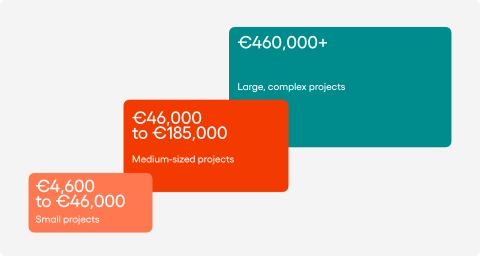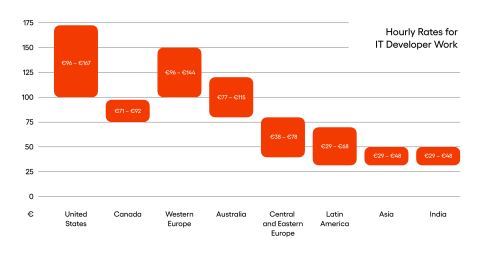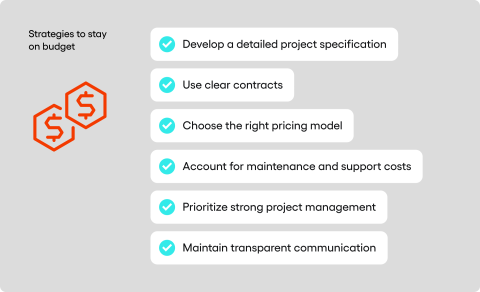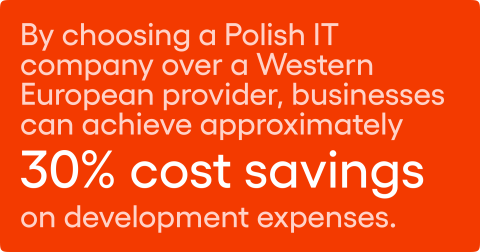Understanding app development costs


Everybody wonders, but most companies hesitate to disclose actual numbers. We do not. That is precisely why we have created this post — to provide transparency on the actual costs associated with IT projects. We will outline the specific elements that contribute to the overall expense, ensuring that when a vendor presents a quotation, it does not come to you as a surprise. Additionally, we provide a simple calculation to highlight potential cost savings when engaging a Polish software company.
Table of contents
Cost breakdown
At first glance, you might wonder why our cost classification doesn’t use rounded figures. The human brain naturally favours them, making numbers easier to process. Most online classifications follow American pricing models, but since this post is designed for a European audience, we’ve converted everything into euros—saving you the trouble of doing the math.
Small projects: €4,600 to €46,000
A small-scale project typically includes a basic application with minimal functionality. This could consist of a simple user interface, essential backend services, and limited customisation options. These projects often serve as prototypes or proof-of-concept applications.
Medium-sized projects: €46,000 to €185,000
Mid-range projects offer greater functionality and a more sophisticated design. Such projects may include mobile applications with user authentication, integrated payment processing, and inventory management capabilities. They require more extensive development and testing efforts compared to smaller projects.
Large, complex projects: €460,000+
Large-scale IT initiatives demand extensive planning, development, and integration. These projects often involve enterprise-grade systems featuring advanced analytics, artificial intelligence-driven functionalities, and numerous third-party system integrations. Scalability and performance optimisation become critical considerations at this level.

Key factors influencing IT project costs
Scope
The scope of an IT project defines its overall objectives and functional requirements. A basic website with static content is significantly less complex than a feature-rich platform that includes user accounts, transaction processing, and real-time data synchronisation. The broader the scope, the greater the resource allocation required, thereby increasing costs.
Scale
Scale determines the number of users, geographical reach, and performance requirements of a system. A small business application serving a limited customer base is considerably less costly than an enterprise solution that must support thousands of concurrent users worldwide, provide multi-language support, and ensure seamless user experiences across various regions.
Complexity
The complexity of an IT project arises from the sophistication of its components. A simple reporting dashboard, for example, incurs significantly lower costs than a machine learning-powered analytics system capable of predicting customer behaviors and personalising interactions. Advanced functionalities and data processing mechanisms directly influence development time and overall costs.
Technologies and tools
The choice of technology stack plays a crucial role in determining project costs. Different programming languages, frameworks, and tools come with varying levels of expertise requirements. For instance, PHP developers earn between €45,000 and €85,000 annually, while Java specialists command salaries ranging from €60,000 to €110,000.
Advanced technologies
Utilising advanced technologies further increases costs due to the specialised expertise required. Implementing artificial intelligence for predictive analytics, integrating blockchain for secure transactions, or incorporating IoT solutions necessitates highly skilled professionals. These technologies not only elevate the project’s complexity but also require rigorous testing and security measures, leading to higher expenses.
Team Composition and location
Labour costs vary significantly based on geographic location. Developers based in the United States typically charge between €96 and €167 per hour, whereas those in Central and Eastern Europe offer more competitive rates, ranging from €38 to €78 per hour. Outsourcing to regions such as Latin America or India can further reduce expenses, with rates as low as €29 per hour.

Industry-Specific Requirements
Certain industries impose stringent regulatory and compliance requirements, which directly affect project costs. Sectors such as finance and healthcare demand high levels of security, data protection, and adherence to legal frameworks. Regulations like GDPR in Europe and HIPAA in the United States necessitate additional security measures and compliance protocols, resulting in increased development time and expenditure.
What drives up the costs of your app development?
Scope Creep
Introducing new features and functionalities mid-project without adjusting the budget causes scope creep.
Example:
Adding new user roles, complex reporting tools, or additional integrations after development has already begun.
How to avoid:
To prevent scope creep, establish a well-defined project scope and implement a structured change management process. Regularly review and formally approve any modifications with all stakeholders to maintain control over project costs.
Limited Testing
Insufficient testing can lead to costly rework when issues are discovered late in the development process.
Example:
Skipping early testing phases results in significant redevelopment efforts when critical bugs emerge close to deployment.
How to avoid:
Incorporate automated testing tools to identify defects early and minimise manual testing efforts. Adopting continuous integration and continuous deployment (CI/CD) practices can also enhance testing efficiency and reduce the risk of late-stage errors.
Integrations with External Systems
Integrating with third-party systems can significantly impact costs, particularly when dealing with legacy infrastructure or highly specialised industry software.
Example:
Complex integrations with outdated ERP systems or niche financial platforms require extensive custom development and troubleshooting.
How to avoid:
Plan integration requirements early in the project lifecycle. Allocate adequate resources for research, testing, and validation of APIs and third-party systems before initiating development to prevent unexpected delays and increased expences.
Strategies to stay on budget
Develop a detailed project specification
A comprehensive project specification serves as the foundation for cost control by minimising misunderstandings and unnecessary revisions.
Best practices:
Clearly define project requirements, user stories, and acceptance criteria. Ensure all stakeholders align on expected functionalities, performance benchmarks, and compliance obligations before development begins.
Use clear contracts
Well-defined contractual agreements help prevent unforeseen expenses and disputes.
Key considerations:
Contracts should specify deliverables, timelines, payment terms, and change management procedures. Establishing these parameters upfront ensures both parties maintain clear expectations regarding project scope and budget.
Choose the right pricing model
Selecting an appropriate pricing model can significantly influence cost predictability and flexibility.
Comparison:
- Fixed-Price Model: Provides financial predictability but may limit flexibility if requirements evolve.
- Time-and-Materials Model: Allows for adaptability but requires close budget monitoring to prevent overspending.
Account for maintenance and support costs
Many organisations overlook post-launch expenses, leading to budget overruns after project completion.
Considerations:
Factor in ongoing maintenance, updates, and technical support as part of the overall project budget. Estimating these costs in advance ensures long-term financial sustainability.
Prioritise strong project management
Effective project management minimises delays and cost overruns.
Role of a project manager:
A dedicated project manager meets milestones, controls budgets, and proactively addresses potential risks. Their oversight significantly improves efficiency and prevents misalignment between teams.
Maintain transparent communication
Clear and consistent communication is essential for cost control and project success.
Best practices:
Regular status updates, scheduled meetings, and well-documented decisions help align expectations and prevent miscommunication. Transparency across all project phases ensures efficient issue resolution and financial oversight.

Cost savings when partnering with a Polish IT company
Wondering whether outsourcing in Poland is still cost-effective? Let’s find out with a simple calculation. By looking at developers’ hourly rates, we can easily determine how much a project can cost.
Developers’ salaries make up a significant portion of the total IT project costs. This means that the location where the project is carried out has a major impact on the final expense.
Comparative hourly rates
| Region | Average Hourly Rate for Senior IT Professionals | Example Rate |
| Western Europe | €75 – €90 per hour | €80 per hour |
| Poland | €50 – €60 per hour | €55 per hour |
Potential Savings

Summary
Understanding IT project costs is essential for making informed decisions and avoiding unexpected expenses. This guide breaks down the cost of app development based on project size, complexity, technologies, and industry-specific requirements. It also highlights key cost drivers, such as scope creep, third-party integrations, and limited testing, and provides strategies to reduce app development costs, including choosing the right pricing model and planning for ongoing maintenance costs.
Additionally, we offer a comparison of app development expenses between Western Europe and Poland, showing that outsourcing to a Polish app development company can lead to significant cost savings without compromising quality.
FAQ
How much does it cost to develop an app?
The app development cost depends on several factors, including the app’s complexity, features, and platform (iOS, Android, or cross-platform development). A simple app may have a lower initial development cost, while more complex apps with advanced app functionality require a higher development budget.
What affects app development costs the most?
Several factors affect app development costs, including the development team, chosen technology stack, third-party services, backend and server infrastructure, user interface design, and the number of mobile app development stages. Working with an experienced app development company helps optimise costs while maintaining a smooth user experience.
What are the hidden app development costs?
Many hidden app development costs arise after the initial development cost, including app maintenance costs, app store fees, ongoing maintenance costs, and fees for third-party services such as payment gateways and analytics tools. Businesses should consider these costs in their total app development cost estimate to avoid unexpected expenses.
How can you reduce app development costs?
To reduce app development costs, companies should conduct thorough market research, prioritise core app functionality, and choose a mobile app development company that offers cost-effective solutions. Opting for cross-platform development instead of separate iOS and Android app development can also lower costs.
What is the cost of app development in the UK?
The cost of developing an app in the UK and EU is generally higher than in other regions. UK app development rates vary based on expertise and project complexity. Many businesses outsource to cost-efficient locations like Poland to achieve significant cost savings while maintaining quality.
What are the ongoing maintenance costs for an app?
Beyond the original development cost, app maintenance costs include bug fixes, performance updates, security patches, and adapting to new OS versions. Businesses should allocate a portion of their app development budget for ongoing maintenance to keep their mobile app running efficiently.
How does app complexity impact development costs?
The app’s complexity significantly influences application development costs. A simple app with basic features will have a lower app development cost, while more complex apps requiring multiple platforms, custom backend infrastructure, and in-app purchases will increase mobile app development costs.
What are the typical app development stages?
The app development process consists of multiple phases, including market research, planning, UI/UX design, coding, testing, and app store submission. Each phase contributes to the overall app development expenses, and skipping steps may lead to higher hidden costs later.
How do app development cost calculators work?
Many businesses use app development cost calculators to estimate their total app development cost. However, these tools provide rough estimates and may not account for all app development expenses, including hidden app development costs, app maintenance, and server infrastructure fees.
What is included in app store fees?
When launching a mobile app, businesses must pay app store fees for distribution. The Apple App Store and Google Play charge developers for listing an iOS app or Android app, as well as taking a percentage of in-app purchases. These fees contribute to the overall cost to develop and maintain an app.
How important is user feedback in the app development process?
Collecting user feedback is crucial for a successful app. It helps refine app functionality, fix bugs, and improve the user interface. Ignoring user feedback can lead to costly revisions and higher mobile app development expenses.
Why choose a Polish app development company over a UK-based firm?
Partnering with a Polish app development company can offer cost savings of up to 30% compared to UK app development firms. Polish app developers provide high-quality mobile app development services at lower development costs, making it a competitive alternative to app development in the UK.
This blog post was created by our team of experts specialising in AI Governance, Web Development, Mobile Development, Technical Consultancy, and Digital Product Design. Our goal is to provide educational value and insights without marketing intent.




